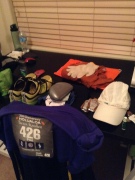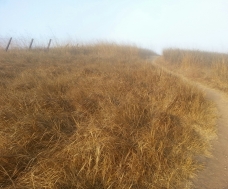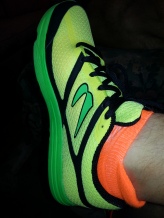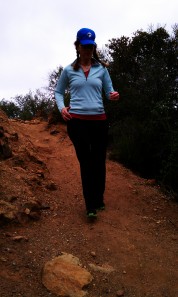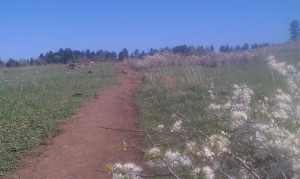
Many months ago, as I was looking through the list of races in the California Marathon and Half Marathon Series, I noticed a race with an intriguing name – “Running with the Bears”. I visited and was impressed by the professionalism of the race website as I reviewed the information about the race course, location, the charity the race supports and the comments from prior runners. Over the next few weeks I found myself going back to the website over and over to learn more about Mountain Circle Family Services, the beneficiary of the proceeds and fundraising efforts resulting from the Running with the Bears. I came to appreciate the services that are provided by Mountain Circle to assist in and improve the lives of foster children in this area. After telling my wife about all the great race reviews and showing her the awesome things Mountain Circle does, I convinced her to register to run the half marathon with me and make the seven and a half hour trek northeast to the little town of Greenville, California for the race.
In the early morning of Friday, August 14th, we began our drive from San Luis Obispo on the central coast of California, out through the agricultural lands of the central valley, up through the state capitol of Sacramento and finally into the foothills of the northern Sierra Nevada mountains. Human population becomes sparse as one heads into the Sierras as the terrain becomes rugged and beautiful with rivers, deep valleys and gorges, and massive pine forests. At about 4:00 pm, we arrived at the Taylorsville campground, our home base for the next couple of days, and setup our tent among the pine and oak trees. Many runners and others were already setup in the campground, but still, there was plenty of space for us. After the long drive, we were hungry so we drove the 10 or so miles over to Greenville (pop. 1100) for the pre-race dinner in the backyard of the new Mountain Circle location. After a pasta and salad dinner along with desert, we heard from the race directors, Josie and Shauna, about the Mountain Circle mission to support the foster children of the area by providing them with a mom and dad that they were missing in their lives. Hearing the story of a former foster kid, now a young adult, in person made our support of the group through the race feel more real and well worth the cost and effort to get here.
After returning to the campground and getting and a good night’s sleep, we we awoke early to arrive at the start area six miles away for the Running with the Bears half marathon by 6:30 am on Saturday morning. Without paying too much attention, we were thinking it was a little chilly in the early morning light until we looked at the car thermometer indicating that it was 38 degrees! Wow, this is still August, right? The area around the race start was buzzing with activity by the time we arrived. The marathon had just started and the half marathon and 10k participants were begi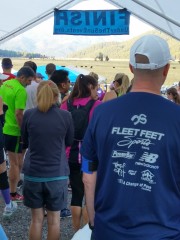 nning to congregate near the start/finish line. These are not Chicago Marathon size crowds but rather an intimate group of 500 people on the edge of the beautiful, barely populated Indian Valley surrounded by mountains highlighted by the rising sun. Cattle grazed across the country road from the start line and throughout the thousands of acres of ranch land stretching before us with a “real” cowboy on horseback in the foreground tending the herd. As race time neared, in true, small town, laid back fashion, the race director announced that the race would start 10 minutes late to allow the restroom line to clear, which made many people happy. And, why not, we had all day to finish this race. There are no time limits. In fact, there are refreshingly few rules to follow. It gave me time to greet Stella, a blue heeler I met on Friday night that looked like a small version of our own Jackson back home. There were many dogs getting ready to run both the half marathon and 10K all excited and ready to go.
nning to congregate near the start/finish line. These are not Chicago Marathon size crowds but rather an intimate group of 500 people on the edge of the beautiful, barely populated Indian Valley surrounded by mountains highlighted by the rising sun. Cattle grazed across the country road from the start line and throughout the thousands of acres of ranch land stretching before us with a “real” cowboy on horseback in the foreground tending the herd. As race time neared, in true, small town, laid back fashion, the race director announced that the race would start 10 minutes late to allow the restroom line to clear, which made many people happy. And, why not, we had all day to finish this race. There are no time limits. In fact, there are refreshingly few rules to follow. It gave me time to greet Stella, a blue heeler I met on Friday night that looked like a small version of our own Jackson back home. There were many dogs getting ready to run both the half marathon and 10K all excited and ready to go.
After the National Anthem, a nice rendition sung live at the start line, the shivering mass of runners began their journey. Becky and I had no time goal so we decided to run at a comfortable pace and enjoy scenery along with food and drinks at the eight aid stations along the course. Eight aid stations is a lot for a half marathon and these were not ordinary. There were the 4077th MASH, hillbillys, cheerleaders, belly dancers, fruit, peanut butter balls and a multitude of other snacks and drinks. The effort put into this race by the aid station volunteers was truly extraordinary. The course followed the edge of the Indian Valley along a mostly flat route with some rolling but no killer hills through the half marathon. As we approached the finish line, something that I’ve never experienced in a race happened. One of the race directors who is also the executive director of Mountain Circle Family Service, Shauna Rossington, ran the last 35 yards of the race with me to the finish line. She then turned around and did it again and again with other runners as they finished. A nice personal show of appreciation for the runners!
After the race, most of the finishing runners stayed in finish area to cheer the remaining runners in, play with the dogs, eat snacks, drink a beer and get a massage (all included in the entry fee). 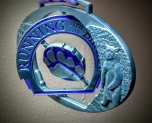 After an hour or two of post-race relaxation the temperatures had warmed into 80s so we gathered our fancy Running with the Bears finisher medals and made our way back to the Taylorsville campground for a nap followed by a stroll in the nearby river. For lunch, we visited the Taylorsville Young’s Market, which offers a surprisingly eclectic selection of meats, cheeses, sandwiches and gourmet coffee.
After an hour or two of post-race relaxation the temperatures had warmed into 80s so we gathered our fancy Running with the Bears finisher medals and made our way back to the Taylorsville campground for a nap followed by a stroll in the nearby river. For lunch, we visited the Taylorsville Young’s Market, which offers a surprisingly eclectic selection of meats, cheeses, sandwiches and gourmet coffee.
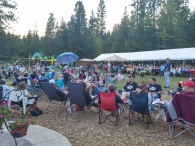 After all this, most would think they were done activities. Not at Running with the Bears! 5:00 pm marked the start of the Hoedown. The Hoedown is the post-race event complete with dinner, live music, dancing and a bar held in the Mountain Circle backyard in Greenville. At this event, special recognition was given to the volunteers and fundraisers involved in Running with the Bears. The organizers and volunteers were amazing throughout the weekend. People that were performing bag check-in at the race in the morning were in formal attire taking drink orders in the evening all with a smile. This was a nice way to end a great weekend that was much more than just a race – it is truly an event.
After all this, most would think they were done activities. Not at Running with the Bears! 5:00 pm marked the start of the Hoedown. The Hoedown is the post-race event complete with dinner, live music, dancing and a bar held in the Mountain Circle backyard in Greenville. At this event, special recognition was given to the volunteers and fundraisers involved in Running with the Bears. The organizers and volunteers were amazing throughout the weekend. People that were performing bag check-in at the race in the morning were in formal attire taking drink orders in the evening all with a smile. This was a nice way to end a great weekend that was much more than just a race – it is truly an event.
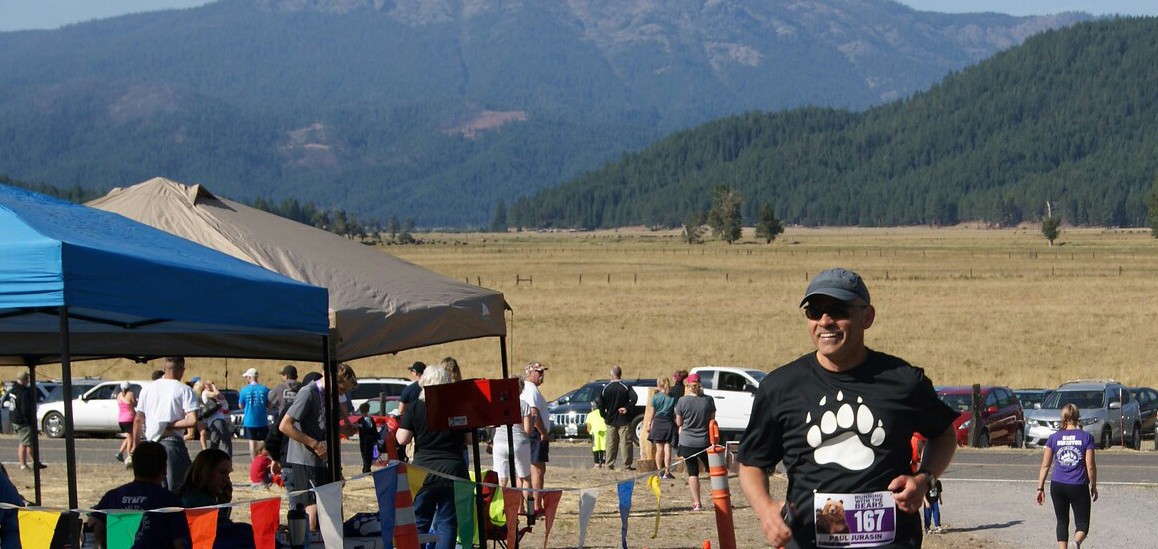

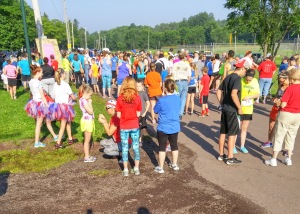 eek to the St. Jude Children’s Research Hospital in support of my Chicago Marathon run in October and if they succeeded I would shave my head. To my surprise and gratitude, my generous colleagues donated over $2200 to St. Jude and to be true to my word, I will gladly shave my head. In fact, because I am a big believer in St. Jude and their mission, I would encourage anyone to take a look at what they do and make a donation if you are so inclined. You can check them out
eek to the St. Jude Children’s Research Hospital in support of my Chicago Marathon run in October and if they succeeded I would shave my head. To my surprise and gratitude, my generous colleagues donated over $2200 to St. Jude and to be true to my word, I will gladly shave my head. In fact, because I am a big believer in St. Jude and their mission, I would encourage anyone to take a look at what they do and make a donation if you are so inclined. You can check them out 
